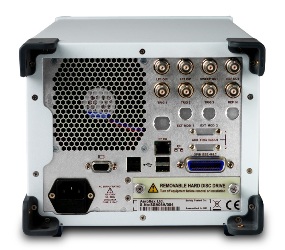Aeroflex introduced the first in its new range of general purpose benchtop RF instruments – the S-Series – at the recent Electronica exhibition in Munich, Germany. The S-Series has been designed to offer simplicity, portability, modularity, and RF performance at an attractive price. Today’s engineers expect instant answers at the touch of a screen. Therefore, as Figure 1 shows, in the S-Series, buttons, rotary controls, and deeply nested software menus have all been replaced by a simple touch-screen interface.
The Aeroflex SGA is the first instrument in the new Aeroflex S-Series, which is planned to include digital signal generators and a range of signal analyzers. The SGA is currently available in two models: the SGA 3, which has an operating frequency range of 100 kHz to 3 GHz, and the SGA 6 covering 100 kHz to 6 GHz. Both models are compact and lightweight with low phase noise, accuracy and fast settling time.

figure 1
TOUCH SCREEN INTERFACE
The SGA is a high specification analog RF signal generator that is a reliable and repeatable signal source solution for general-purpose, aerospace and military test applications in laboratory, factory and field environments. The intuitive LCD touch-screen interface allows modulated or swept RF signals to be set up using fewer keystrokes than required by traditional soft key models, thus saving the engineer’s time and reducing the risk of error.
Portability is a key feature of the new instruments. The SGA is half rack width and 4U high, and weighs less than 17 lbs (8 kg) – less than half the weight of its predecessor. This makes it simple for one person to move it around the laboratory or to use in the field. A modular format, featuring the new Aerolock™ locking mechanism, allows additional RF instruments such as a second signal generator and combiner to be mechanically coupled externally by the user, as shown in Figure 2.

figure 2
PHASE NOISE
A typical single sideband (SSB) phase noise specification of -135 dBc/Hz at 20 kHz offset from a 1 GHz carrier means that the SGA signal generator can easily measure receiver selectivity beyond 80 dB. Fast frequency settling times of 1 ms in conventional frequency selection mode, or 100 µs in list mode, make the SGA particularly suited for frequency hopping and semiconductor test applications, as well as ensuring maximum throughput in a production environment.
Maximum RF output power is +13 dBm, with a resolution of 0.01 dB, and a high power option is available to extend the maximum calibrated RF level to +20 dBm. Power level can be switched rapidly using an electronic attenuator, in less than 100 µs to within 0.1 dB of final value, and repeatability is better than 0.05 dB. A digital sweep of carrier frequency, RF level and modulation source is included, with single, continuous or externally triggered modes, as well as a list mode sweep facility.
INTERNAL AND EXTERNAL MODULATION
An AM/FM/phase modulation option adds four internal 10 MHz oscillators and two external modulation inputs, offering a range of waveforms and a wide range of possible modulation modes: single AM, FM or PM (phase modulation); dual AM and FM (or PM); and dual external AM and FM (or PM). This allows up to six modulation channels to be active at one time. A pulse modulation option allows the generation of fast rise time signals to meet the demands of radar and electronic counter measures and counter-counter measures (ECM/ECCM) testing.
For remote operation the SGA is LXI Class C compliant. USB, LAN and GPIB interfaces are all supported, using SCPI format commands where possible, with connections on the rear panel (Figure 3). Remote desktop and VNC are also supported allowing off-site remote control.

figure 3
A reverse power protection (RPP) option is also available for the SGA-3, and provides additional protection to the RF output if excessive RF or DC power is accidentally applied.
The quality of the RF performance also extends beyond the specification. Additional refinements include ensuring that no positive RF level transients are generated by any frequency or level changes, and class-leading source VSWR specification to improve the RF level accuracy under non-ideal load match conditions.
To see first hand the features of the SGA Analog Signal Generators click on the video.
